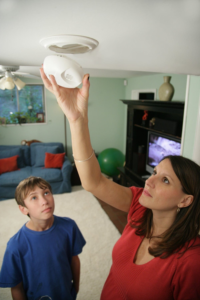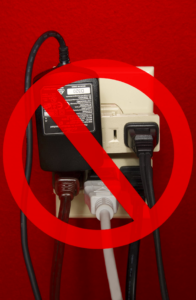Home Safety Tips
Best practices to prevent a fire
Install and test smoke alarms
 Because home fires account for the highest proportion of fire fatalities, it’s important to take steps to make sure that you and your family are quickly notified if a fire starts at your house. There’s no better alert for a house on fire than fire alarms.
Because home fires account for the highest proportion of fire fatalities, it’s important to take steps to make sure that you and your family are quickly notified if a fire starts at your house. There’s no better alert for a house on fire than fire alarms.
It seems simple, but these compact devices are quite literally life-saving. The NFPA reports that 40 percent of home fire deaths occurred in houses with no smoke alarms.
Just having smoke alarms isn’t enough. You need to make sure they’re working. According to the NFPA, 17 percent of home fire deaths occurred in houses that had smoke alarms but in which none of those alarms were working.
In short, over half of home fire fatalities can be avoided by installing smoke alarms and making sure the ones you have are working. If you don’t have smoke alarms in every bedroom and living area and on every floor of your home (basements and attics included), buy them. You can find them at most home improvement stores, big box stores, and Amazon. Then, install them by mounting them to the ceiling or wall no more than a foot from your ceiling.
Next, make sure each smoke alarm will properly alert you to your house on fire. Checking your smoke alarms is an easy, two-step process:
- Locate the test button on your smoke alarm.
- Press the button and listen for a loud sound (it can be helpful to gather your kids before doing this so they know the sound of the smoke alarm).
If the alarm sounds, it’s working properly. If your smoke alarms are battery-operated, you can take an extra step by marking a date on your calendar that recurs annually. On that day, replace the batteries in all of your smoke alarms.
Reduce fire threats in your home
To reduce your risk for a home fire, do these things:

Check your cords: Never plug in a device that has a frayed or worn cord. Also, check your cords periodically to see if they’ve frayed since you last looked closely. Also, avoid putting cords under rugs. While it does reduce tripping hazards, the cords can build up heat, presenting a fire hazard, especially as the cord gets worn down by foot traffic.
Reduce clutter: Fire needs fuel. Excess clutter can feed a fire, allowing it to grow rapidly which, in turn, poses a greater risk. Keep surfaces cleared and avoid piles on the floor. It’s especially important to keep clutter away from electric outlets and heat sources.
Don’t overload electrical outlets: If your breaker trips or your lights dim when you turn on a certain device, it could be a sign your outlet is overloaded. Move to a different outlet to be safe. Also, periodically feel your outlets. If they’re warm to the touch, unplug everything and wait for it to cool. Try plugging one device back in, but keep feeling the outlet. If it stays warm, get an electrician involved.
Monitor candles: Never leave a candle unattended. Also, mind where you place each candle. Candles should always be set on non-flammable surfaces and spaced appropriately from surrounding items.
Move matches and lighters out of kids’ reach: Fire can fascinate kids and teens alike. To prevent temptation, move fire starters out of sight and out of reach.
Cook with care: Cooking caused more than half of home fires in 2018. Never leave a stovetop unattended, and don’t assume you’ll hear the oven timer from a different room. Also, teaching proper kitchen protocols is an important piece of fire safety for kids. Teach your kids to stay away from hot surfaces, and enlist them to help you monitor things as they cook. Never rely on your kids to be in charge of cooking, however.
Monitor heating devices: Think through how you heat your home. If you have a furnace, clean the filter. If you use portable heating devices, place them far enough away from any other items and put them on a timer. If they don’t have an automatic shutoff, you can power them through a plug-in timer. If you use a fireplace, clear items away from the front of it and take steps to avoid chimney fires. Basically, your home’s heat sources all pose fire hazards. Be mindful of them.
- Clean your dryer filter: Dryers cause nearly 3,000 home fires each year — and a third of them could have been avoided with proper lint screen cleaning. Clear your dryer filter after every load.
- Have — and know how to use — a fire extinguisher: Store a fire extinguisher near your kitchen and any other high-risk areas like fireplaces. Also, get familiar with using it. To extinguish a fire, you’ll need to pull the pin, aim toward the base of the fire, slowly squeeze the lever and pass the spray from side-to-side.
Create a fire escape plan
The Red Cross says that only 26 percent of families have a fire escape plan in place. Thinking about your house on fire probably gives you anxiety, but it’s important to mentally walk through the steps you’d take in this scenario. It’s a key piece in fire safety for kids too. If every member of your family knows exactly what to do in case a fire, they’ll all be ready to respond more quickly and calmly.
Here are a few key components of making your fire escape plan:
- Each family member should know at least two routes out of your home.
- Each bedroom should have two routes from it.
- Any bedrooms on the second story should be equipped with a fire escape ladder, and kids should know how to use them.
- Make sure kids know how to open windows and remove screens.
- Talk with your kids about firefighters, helping them get comfortable with the idea of these strangers coming into the house to help so they don’t hide from them.
- Pick a meetup place a safe distance from your home where you can reunite once you get out of the house.
Ready.gov recommends practicing your fire escape plan twice a year. As you do, you can take steps to make your fire escape plan more effective:
- Blindfold kids and practice the route with them so they feel comfortable navigating it in the dark.
- Look for tripping hazards along the route and rearrange as needed to keep pathways consistently clear.
- Make it a game with your kids and time them, helping them to learn their routes faster without too much stress.
Tips to teach your kids about fire safety
Each year, 300 people lose their lives because a home fire starts as a result of a child playing with fire. Clearly, we can all benefit from taking the time to learn fire safety with kids. This doesn’t have to be a scary subject, but it is important to stress the seriousness of fire with your children.
More than anything, make sure they know that if they hear a smoke alarm, smell smoke or see a fire, they need to get out of the house as quickly as possible.
Additionally, you can practice fire safety with your kids by doing the following:
- Practice your escape plan.
- Teach them stop, drop and roll if any of their clothes catch fire.
- Learn the sound of smoke alarms with them.
- Instruct them not to open a door if they see smoke under it or if it feels hot to the touch.
- Teach them how to dial 911.
- Help them learn the importance of staying outside the house if it’s on fire (some kids will be tempted to go back in for family members, pets or possessions).
- Learn about smoke together and teach them to go low to avoid smoke.
- Teach them to be careful around hot surfaces, candles and the fireplace (if applicable).
- Consider touring your local fire station with your kids to help them feel safe with firefighters.
What to do during a home fire
If a fire starts at your house and it’s small and contained (like a stovetop fire), get your fire extinguisher and put it out. If the fire grows before you can extinguish it, evacuate your family and call 911 immediately.
If the fire has spread before you become aware of it, getting out of the house and staying out is the most important thing. It can be tempting to go back into your house to grab precious items but don’t. Once you’re safely outside, call 911 right away. The faster you call emergency responders, the faster they can show up, and the greater the likelihood they’ll be able to save the items you value.
As you exit your home, go low to avoid smoke, and feel doors before opening them. If the door is warm, use a different path. If not, open it slowly while holding your breath to prepare for an influx of smoke. If your clothes catch fire, cover your face with your hands and stop, drop and roll.
The above data is for informational purposes provided by outside source.
Address
405 N. Bushnell Street
P.O. Bo 508 (mailing address)
Sheridan, IL 60551
(815) 496-2296 Non-emergency
DIAL 911 for EMERGENCY
(815) 496-3401 Fax